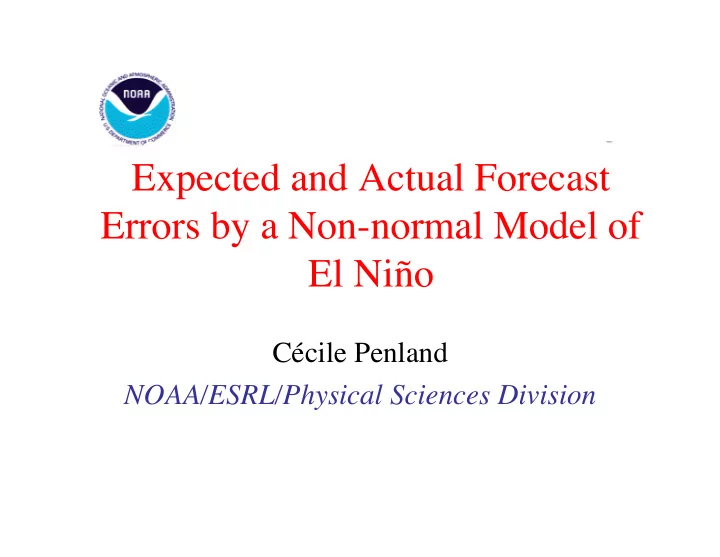

Expected and Actual Forecast Errors by a Non-normal Model of El Niño Cécile Penland NOAA/ESRL/Physical Sciences Division
Outline •Some phenomenology: What is El Niño –The Annual Cycle –Deviations from it, especially El Niño •An empirical-dynamical model •Uncertainty and errors
Size of the annual cycle ( o C). Typical size of El Niño ~ 1-3 o C
Linear Inverse Modeling Assume linear dynamics (dropping the primes): d T /dt = B T + ξ , with < ξ ( t + τ ) ξ T ( t ) > = Q ( t ) δ ( τ ) For now, we’ll assume additive noise, although that assumption is false . Q ( t ) is periodic. Corresponding FPE: [ ] [ ] � � � 2 p ( T , t ) 1 � � = � + B T p ( T , t ) Q ( t ) p ( T , t ) ij j ij � � � � t T 2 T T ij ij i i j
From the FPE. p ( T , t + τ | Τ ο , t ) is Gaussian, centered on G ( τ ) Τ ο where G ( τ ) = exp( B τ ) = < T ( t + τ ) T T ( t ) >< T ( t ) T T ( t ) > -1 . The covariance matrix of the predictions: Σ ( t , τ ) = < T ( t + τ ) T T ( t + τ ) > − G ( τ ) < T ( t ) T T ( t ) > G T ( τ ) . Further, � < T ( t ) T T ( t ) > = B < T ( t ) T T ( t ) > + < T ( t ) T T ( t ) > B T + Q( t ) � t
Digression : The disturbing assumption of additive noise. Instead of d T /dt = B T + ξ , the system is actually of the form d T /dt = B T + ( A T + C ) ξ 1 + D ξ 2 . All of the LIM formalism follows through, with the identification B → B + A 2 /2 ; Q → < ( A T + C ) ( A T + C ) T > + DD T G ( τ ) → exp { ( B + A 2 /2 ) τ } Note: p ( T , t + τ | Τ ο , t ) is no longer Gaussian, but G ( τ ) Τ ο is still the best prediction in the mean square sense.
Eigenvectors of G ( τ ) are the “normal” modes { u i }. Eigenvectors of G T ( τ ) are the “adjoints” { v i }, (Recall: G ( τ ) = < T ( t + τ ) T T ( t ) >< T ( t ) T T ( t ) > -1 ) and uv T = u T v = 1 . Most probable prediction: T ( t + τ ) = G ( τ ) T ο ( t ) The neat thing: G ( τ ) ={ G ( τ ο ) } τ / τ ο . If LIM’s assumptions are valid, the prediction error ε = = Τ ( t + τ ) − G ( τ ) Τ ο does not depend on the lag at which the covariance matrices are evaluated. This is true for El Niño; it is not true for the chaotic Lorenz system.
Several sources of expected error and uncertainty: • Stochastic forcing: Σ ( t , τ ) = < T ( t + τ ) T T ( t + τ ) > − G ( τ ) < T ( t ) T T ( t ) > G T ( τ ) • Uncertain initial conditions: < δ T ( t + τ ) δ T T ( t + τ ) > i.c. = G ( τ ) < δ T ( t ) δ T T ( t ) > G T ( τ ) Sampling errors when estimating G ( τ ) : • � < � G ik � G jm > T k ( t ) T m ( t ) < δ T ( t + τ ) δ T T ( t + τ )| T ( t ) > ij,Samp = km
Expected error in Niño 3.4 anomaly forecast
Conclusions • Expected and actual errors can be a useful diagnostic tool • El Niño is mainly a linear process maintained by additive and multiplicative cyclostationary stochastic forcing • Initial condition errors grow and then decay
Recommend
More recommend